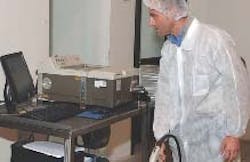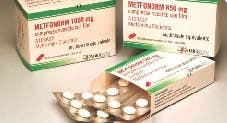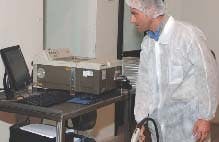The utilization of near-infrared (NIR) spectroscopy for quality control (QC) of pharmaceutical tablets has become increasingly widespread over the past decade. This is due in part to stricter regulatory control of QC in drug manufacturing, but also the increasing realization that it may no longer be practical to use a wide range of testing methods within one plant.
Chapter 5.30 of the Good Manufacturing Practice (GMP) guidelines specifies that a pharmaceutical company must “…provide suitable procedures or measures to guarantee the identification of the material contained in each recipient.” [1] Traditionally, companies used a number of different analysis methods for raw materials testing, as suggested in early versions of Pharmacopoeia methods. However, regulatory guidelines now advocate that nearinfrared spectroscopy may be the best universal method for raw material testing.
Characterizing Raw Materials
Raw material analysis is an essential process in any pharmaceutical manufacturing laboratory. According to Annex 8, EU GMP:
“…the identity of a complete batch of starting materials can normally only be ensured if individual samples are taken from all the containers and an identity test performed on each sample…It is permissible to sample only a proportion of the containers where a validated procedure has been established to ensure that no single container of starting material has been incorrectly labeled …” [2]
In compliance with GMP guidelines, identification of the raw materials must be executed on each API and excipient. Since most pharmaceutical manufacturing laboratories receive many raw materials and the number is only getting bigger, this can be a difficult job in terms of time and cost.
Regulatory Guidance
Prior to the European Pharmacopoeia 5th edition (2002), there was no universal method recommended by pharmaceutical guidelines relating to raw materials analysis. Different methods were specified for each raw material to be identified — a time-consuming process. It also was costly, not only the outlay for different instruments, reagents and other chemicals, but also the decreased productivity of laboratory instruments and personnel.
Traditionally, raw material identification was performed on a statistical basis, where only a certain percentage of each batch would be analyzed. However, regulations now require the identification of every single container of each batch of raw materials, regardless of whether they are actives or excipients. The only exceptions to this requirement are sucrose, talc and sodium chloride.
Additionally, when using traditional Pharmacopoeia methods for raw material analysis, more than one test may be mandated. For example, when analyzing lactose, it may be necessary to use IR (infrared) spectroscopy, thin layer chromatography and melting point analysis.
It is evident that where there are many raw materials to be analyzed, using multiple analytical methods isn’t practical. There are three possible solutions: mandating that suppliers provide larger sized containers, validating suppliers or finding an alternative method of analysis.
NIR Spectroscopy
Several recently revised sets of guidelines advocate NIR spectroscopy as a universal method for the identification of raw materials:
- European Pharmacopoeia 5 (2005), p. 59
- EMEA – CPMP/QWP/3309/01 and EMEA/CVMP/961/ 01: Note for Guidance on the use of near-infrared spectroscopy by the pharmaceutical industry and the data requirements for new submissions and variations, EMEA, London, 2003.
- USP 29 (2006), p. 2979. “…NIR spectroscopy is a well established technique in the food, chemical . . . and petrochemical industry, and has now also been used for many years in the pharmaceutical industry. The technique appears to be useful for the identification and assay of pharmaceutical substances, the identification and assay of such substances in the finished products, as well as for in-process control and for monitoring purposes.” [3] —EMEA, Note for Guidance
Identifying a substance with NIR spectroscopy is based on a comparison between the spectral data of the substance being analyzed and the spectral data of multiple samples of batches in a reference library. Chemometrics should be used to compare the data and derive conclusions.
For raw material characterization, NIR spectroscopy has been found to have some unique benefits. It enables analysis of the starting material in the original packaging without opening the primary container, reducing the risk of cross-contamination and abolishing the need to conduct the analysis within a designated area. NIR spectroscopy reduces the time down to roughly two minutes for each analysis and can be used from pilot- to production-scale blenders in order to follow the development of a pharmaceutical product.
The method can be used to collect high-quality reflectance spectra of both the active ingredient and excipients, and is sensitive to both the chemical and physical properties of the powder blend. It can also be beneficial within pharmaceutical manufacturing, as it is non-contact and non-destructive, highly reproducible, rapid and does not require any sample preparation.
Within a pharmaceutical plant, NIR spectroscopy can be carried out at multiple stages in the manufacturing process — in the raw materials warehouse, the dispensing area or the QC lab. When using NIR spectroscopy, each company must choose its own “best place” to locate the analyzer.
If the analysis is carried out in the warehouse (Figure 2, p. 42), no sampling is required by GMP guidelines, so the time for analysis is reduced. In addition, because raw materials analyzed in the warehouse do not have to be transported for analysis, workflow is improved.
Neither is there a need for sampling if the analysis is done in the dispensing area. In addition, there are cost savings on reagents and other chemicals. However, analysis must be carried out by non-specialized personnel in both the warehouse and dispensing areas. Further, the flow of raw materials through the manufacturing plant is interrupted if done in the dispensing area.
Another option is to place the analyzer in the QC laboratory. Although time per analysis would be reduced, GMP guidelines require sampling, which would interrupt the flow of raw materials through the plant.
NIR at Abiogen
Abiogen Pharma S.p.A. (Pisa, Italy) manufactures its own products and carries out contract manufacturing for the pharmaceutical sector. The main areas of Abiogen’s business are R&D and manufacturing of pharmaceutical products, and the company has laboratories dealing with QC (chemical and microbiological), pharmaceutical develop-ment (analytical development, QC of medicinal products and formulation) and research.
Figure 1: Metfonorm, Abiogen’s diabetology product (metformine
hydrochloride active ingredient).
Prior to adopting NIR spectroscopy for raw material analysis, Abiogen used individual methods for each raw material container in accordance with the European Pharmacopoeia guidelines, including UV-Vis spectroscopy, IR spectroscopy and gas chromatography. Conducting raw material identification with these methods proved to be extremely time-consuming. Additionally, the total amount of incoming raw materials doubled from 2001 to 2006, while the number of different types of raw materials arriving at Abiogen tripled in this period.
To continue sampling each different raw material individually, it would have been necessary to engage a second sampler to cope with the workload. Besides a cost outlay, it would also require a great deal of planning and organization, taking scientists away from the laboratory and increasing their workload.
In particular, metformine hydrochloride was entering the plant in ever-increasing quantities. At a standard weight of 25 kg per container, this material was originally analyzed using IR spectroscopy. This no longer proved viable when the number of incoming containers and the time required for material analysis continued to rise.
While examining alternative methods of analysis, increasing the container sizes was ruled out, since that can only be done for low-cost raw materials, and would have had a significant impact on transport and weighing systems. Although GMPs allow for fewer tests on raw materials that are supplied by qualified vendors, this was not a suitable alternative for Abiogen, because the qualification process takes a considerable amount of time. Also, GMPs require periodic vendor re-qualification, which could result in a future need to change suppliers.
Having considered these alternatives, Abiogen chose to implement NIR spectroscopy with an FT-NIR analyzer. Abiogen engineers decided to place the analyzer in the raw materials warehouse, in order to comply with GMP guidelines while minimizing the time per analysis and analyzer operating costs. Since the implementation, Abiogen has significantly increased productivity due to no longer having to sample each container of raw material, and has reduced its instrument and chemical costs.
Conclusion
NIR spectroscopy can be an extremely accurate and beneficial method for the analysis and QC of raw materials in pharmaceutical manufacturing plants. Using NIR can help laboratory and manufacturing workers improve productivity productivity by reducing analysis time, and can support regulatory compliance as well.
Figure 2: Thermo Scientific Antaris FT-NIR analyzer in Abiogen’s raw
materials warehouse.
In recent years, NIR spectroscopy has been recommended as a valuable tool for raw material analysis by a range of pharmaceutical guidelines, including the Pharmaceutical Analytics Science Group’s guidelines for the development and validation of NIR spectroscopic methods, as well as the European Agency for the Evaluation of Medical Products’ note for guidance on the use of NIR spectroscopy by the pharmaceutical industry. The practical example of Abiogen’s experience shows that using NIR spectroscopy for raw material analysis can save a significant amount of time in the laboratory, improve productivity and reduce operating costs.
References
- Chapter 5.30, GMP guidelines
- Annex 8, EU.GMP
- EMEA, Note for Guidance on the Use of NIR Spectroscopy by the
Pharmaceutical Industry and the Data Requirements for New
Submissions and Variations.
About the Authors
Nicola Cecconi is the Chemical QC Manager for Abiogen Pharma
S.p.A, and Emiliano Genorini is European NIR Product Manager,
Thermo Fisher Scientific.








